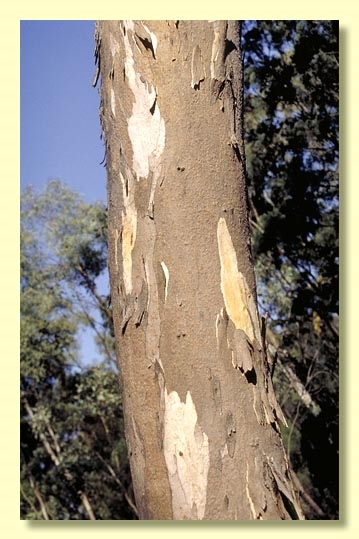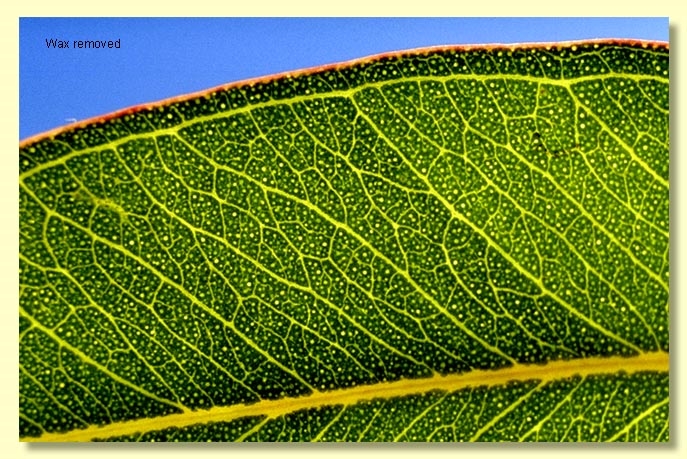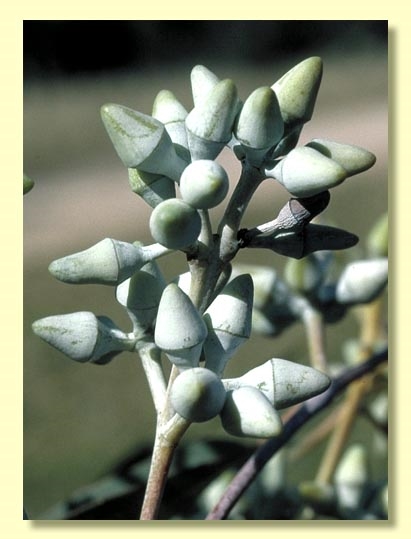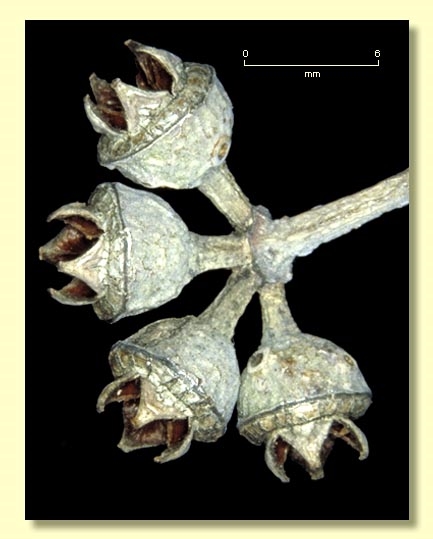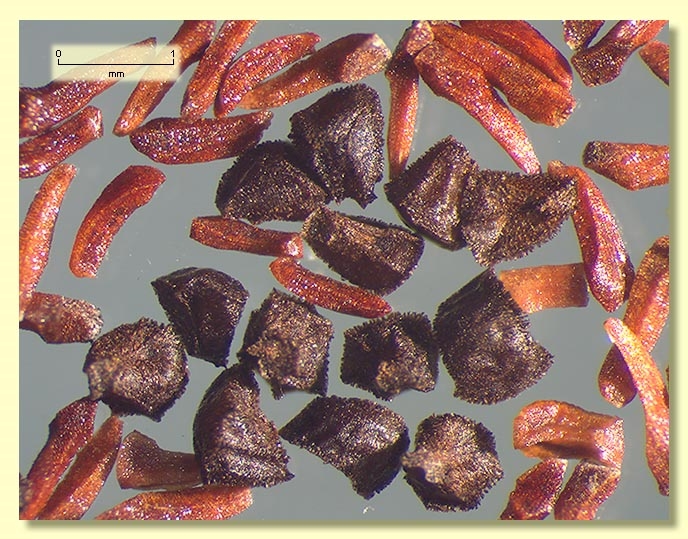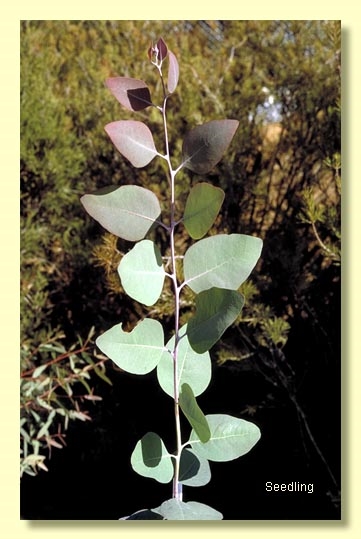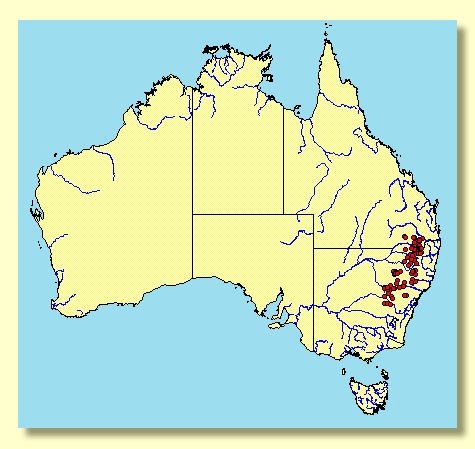Euclid - Online edition
Eucalyptus dealbata
Eucalyptus | Symphyomyrtus | Exsertaria | Erythroxylon
Eucalyptus viminalis Labill. var. dealbata (A.Cunn. ex Schauer) C.Moore & E.Betche, Handb. Fl. New South Wales 202 (1893); E. tereticornis var. dealbata (A.Cunn. ex Schauer) H.Deane & Maiden, Proc. Linn. Soc. New South Wales 24: 466 (1899); E. umbellata var. dealbata (A.Cunn. ex Schauer) Domin, Biblioth. Bot. 89: 447 (1928). T: Wellington Valley, NSW, Nov. 1825, A.Cunningham 71; holo: (?)NSW; iso: K, MEL.
Bark smooth throughout, or partly rough due to persistent slabs of grey bark on base of trunk; smooth bark white, grey, yellow, pink, brown, coppery or orange, branchlets glaucous.
Juvenile growth (coppice or field seedlings to 50 cm): stem rounded or square in cross-section, glaucous; juvenile leaves always petiolate, opposite for 5 to 7 nodes then alternate, ovate, 6.5–8 cm long, 3–4.2 cm wide, blue-green to blue-grey or glaucous.
Adult leaves alternate, petiole 0.8–3 cm long; blade lanceolate to ovate, 5.5–14 cm long, 1–4 cm wide, base tapering to petiole, concolorous, dull, blue-green to blue-grey or glaucous, side-veins greater than 45° to midrib, moderately reticulate, intramarginal vein parallel to and well removed from margin, oil glands island.
Inflorescence axillary unbranched, peduncles 0.5–1.5 cm long, buds 7, 9 or ?11 per umbel, pedicellate (pedicels 0.1–0.4 cm long). Mature buds diamond-shaped to ovoid (0.6–1.3 cm long, 0.35–0.5 cm wide), glaucous, scar present, operculum conical (0.4–0.8 cm long), outer stamens erect, some inner irregularly inflexed, anthers cuboid to oblong, versatile, dorsifixed, dehiscing by longitudinal slits (non-confluent), style long, stigma blunt or tapered, locules 3 or 4, the placentae each with 6 vertical ovule rows. Flowers white.
Fruit sessile or pedicellate (pedicels 0–0.4 cm long), hemispherical, 0.2–0.6 cm long, 0.5–0.7 cm wide, disc raised-convex to oblique, valves 3 or 4, strongly exserted.
Seeds dark brown to black, 1–1.5 mm long, pyramidal or cuboid, dorsal surface pitted, margin toothed, hilum terminal.
Cultivated seedlings (measured at ca node 10): cotyledons reniform to oblong; stems square in cross-section, often winged, usually glaucous; leaves always petiolate, opposite for 4 to 6 nodes then alternate, ovate, deltoid or orbicular, 5–11.5 cm long, 3.3–6.2 cm wide, base truncate or tapering, apex pointed, usually glaucous.
Flowering has been recorded in September, October and November.
A small tree from the slopes and tablelands mostly west of the Dividing Range in central and northern New South Wales from about Grenfell and Cowra northwards and west as far as hill south of Nymagee, extending north into the Stanthorpe, Warwick, Leyburn, Inglewood, Texas region of south-east Queensland, often in granite and porphyry country.
Eucalyptus dealbata belongs to the group of red gums which is distinguished by having buds with the stamens mostly erect, fruit where the disc is united to the ovary roof and by the black, toothed, cuboid to pyramidal single-coated seed. Fifteen species belong to this group: E. amplifolia, E. blakelyi, E. chloroclada, E. dealbata, E. dwyeri, E. flindersii, E. gillenii, E. glaucina, E. infera, E. kabiana, E. nandewarica, E. nudicaulis, E. tereticornis, E. terrica and E. vicina.
Within this group, E. dealbata is notable for its bright coppery freshly exposed bark in season and glaucous juvenile leaves, buds and fruits. The buds of E. dealbata are usually very glaucous, rhomboidal and conspicuously fatter with a shorter operculum than those of E. blakelyi and E. dwyeri. To the south of its distribution, e.g. near Bethungra and Cowra, E. blakelyi (which can have buds that are glaucous and non-glaucous) also occurs with glaucous buds of typical fusiform shape. In this area, the distinction between E. dealbata and E. blakelyi can be difficult, as intergrades between the two are common, with buds intermediate in size. On plains to the north-west of its distribution is E. chloroclada, which is normally rough-barked on the trunk and has non-glaucous buds. E. terrica, from the Inglewood and Warwick region of Queensland, also has rough bark on the trunk and non-glaucous buds. On stony sites west almost to the River Darling is E. vicina, which is glaucous in the seedling leaves but not so in the similarly-shaped buds and fruits. Another related red gum, E. nandewarica, occurs in an enclave in foothills near Kaputar north-east of Coonabarabran. It differs from E. dealbata by the lower stature, narrowly lanceolate juvenile leaves and small buds (sometimes in threes) with inflexed stamens. E. amplifolia from the subcoastal and tableland areas of New South Wales extending just across the border into Queensland, differs by having non-glaucous buds and by its larger orbicular to deltoid glossy juvenile leaves. E. tereticornis, a common well formed tree in eastern Australia from Bega to the top of Cape York Peninsula, and E. kabiana (its mallee form from Mt Beerwah in the Glasshouse Mountains), differ by having non-glaucous buds with a long narrow operculum.
One red gum in this group with glaucous buds is E. glaucina. It grows in the low coastal ranges and tablelands of central-northern New South Wales and differs from E. dealbata by having larger orbicular to ovate juvenile leaves, 5–6.5 cm wide and by having buds that are more robust with a longer operculum. E. flindersii, from the slopes and summits of peaks in the Northern Flinders Range and some nearby areas of South Australia, differs by having non-glaucous buds which are commonly three-budded in each umbel. E. gillenii, from the ranges of north-western South Australia and Central Australia, and E. nudicaulis, from the Mt Isa region in the north-western part of Queensland, have non-glaucous buds and lanceolate juvenile leaves. E. infera, an odd eucalypt from the Warwick region in Queensland, has non-glaucous buds which have the long narrow operculum like E. tereticornis but has juvenile leaves similar to the swamp gum E. camphora that are ovate to orbicular, with an emarginate apex and margins often with shallow crenulations.
Within its area of occurrence, E. dealbata may be confused with two other smooth-barked red gums from the series Liberivalvae, i.e. E. prava and E. seeana. E. dealbata can be distinguished by having fruit with an ascending disc that is fused to the remains of the ovary roof, unlike the annular disc of series Liberivalvae that is free from the remains of the ovary roof. E. seeana can be further distinguished by having non-glaucous buds and fruit.


